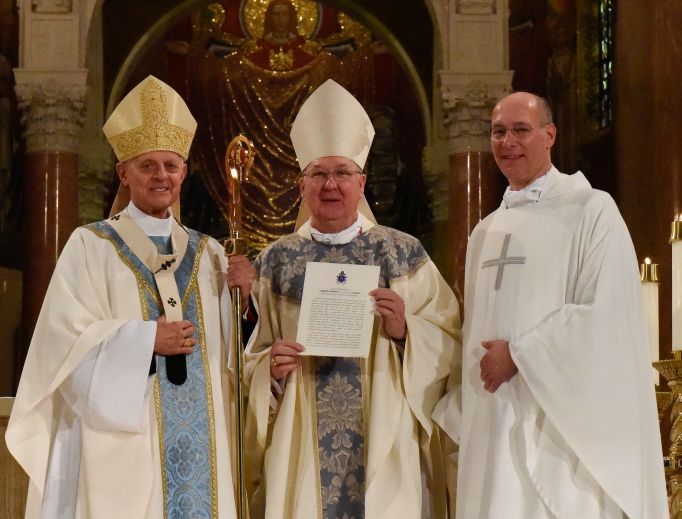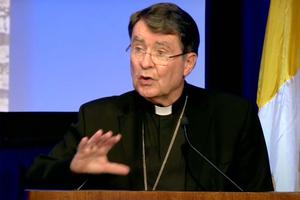National Shrine’s ‘Crowning Jewel’ Dedicated
Trinity Dome Mosaic Completes America’s Home Church

WASHINGTON — With the dedication of the magnificent Trinity Dome on the Solemnity of the Immaculate Conception, Dec. 8, the Basilica of the National Shrine of the Immaculate Conception marked its completion in just under 100 years from the placing of its foundation stone in 1920.
More than 2,000 worshippers filled pews of the shrine’s Great Upper Church for a Mass and festive dedication that featured Washington’s Cardinal Donald Wuerl, surrounded by fellow bishops and cardinals, blessing the Trinity Dome, as a cloud of incense billowed toward the “crowning jewel,” as the new dome is described, of the largest Catholic church in the United States and North America.
Cardinal Kevin Farrell, the prefect of the Dicastery for Laity, Family and Life in Rome, brought an apostolic blessing from Pope Francis, who blessed a preliminary segment of the mosaic when the Pope made his visit to the basilica Sept. 23, 2015. The letter was presented to Cardinal Wuerl and Msgr. Walter Rossi, the rector of the basilica, who shepherded the Trinity Dome to completion.

“The Trinity Dome brings to completion the construction on the National Shrine begun in 1920,” Msgr. Rossi told the Register. “This shrine was built and continues to exist because of the devotion of American Catholics to Our Lady and belongs to Catholics throughout the United States. The Trinity Dome is the result of the goodness of American Catholics as well; and with this dome, the Catholic faithful have helped bring to completion the building of ‘their’ church, which has been a hundred years in the making.”
Composed of more than 14 million pieces of Venetian glass and fabricated by hand in Spilimbergo, Italy, the mosaic of the Trinity Dome depicts the Blessed Virgin as the Immaculate Conception, the Holy Trinity, the Four Evangelists and American saints, such Kateri Tekakwitha, Juan Diego and Elizabeth Ann Seton.
Several saints, including Pope St. John Paul II, who named the shrine a basilica, and Pope Blessed Paul VI, who donated his coronation tiara to the basilica, are also portrayed. The words of the Nicene Creed encircle the base of the Trinity Dome.
The basilica pulled out all the stops to make the blessing of the Trinity Dome a beautiful and solemn occasion — from the vested members of the Knights of Malta, the Dames of Obedience, Knights of Columbus, and Equestrian Order of the Holy Sepulchre of Jerusalem processing in quietly to the presence of the cardinals and bishops and the basilica’s renowned choir leading Marian hymns. The apostolic nuncio to the United States, Archbishop Christophe Pierre, attended the ceremonies.
“This magnificent tribute in stone, glass, marble and mosaic to Mary, Mother of Jesus, Mother of God and our mother, invites all of us to recognize not only the special role of Mary in our life, but the unique glory that is hers in her Immaculate Conception,” Cardinal Wuerl said in his homily.
“What we today celebrate, dedicate and consign to the ages to come is the completion of the basilica represented in the adornment of the entire interior of the great dome, with millions of pieces of colored tile culminating in the presentation of Mary with the title of her ‘Immaculate Conception,’ under the radiant image of the Triune God, Father, Son and Holy Spirit,” continued the cardinal, who recalled coming to the shrine as a young seminarian when the great church’s walls were mostly unadorned, except for the towering Christ in Majesty mosaic by artist Jan Henryk de Rosen.
Cardinal Wuerl traced the history of the basilica, noting that, “on the very spot where the basilica now stands,” Cardinal James Gibbons of Baltimore had on Sept. 20, 1918, said, “Let us, too, offer to the world an example of Catholic gratitude, faith and love by erecting at Washington the National Shrine of the Immaculate Conception at whose altars your children and your children’s children will be proud to pray and worship.” Cardinal Gibbons laid the cornerstone in 1920.
Cardinal Wuerl traced the history of the basilica even farther back, when he recalled that, in 1846, the Catholic bishops of the U.S., at the sixth Council of Baltimore, chose Mary under her title of the “Immaculate Conception” to be the patroness of the United States.
Like Msgr. Rossi, Cardinal Wuerl praised the generosity of American Catholics for contributing financially over the years to the basilica, including at one point donating their gold jewelry, which was fashioned into the “first chalice of the National Shrine,” which was one of the chalices used during the Mass for the Dec. 8 dedication.
Attending the dedication with special reason to be excited was Martin Rambusch of Rambusch Design Co., a New Jersey firm that, since being established in 1898, has become one of the premiere decorators of churches.
With guidance from the basilica’s Iconography Committee, artists and craftsmen at the Rambusch firm sketched out the artwork for the Trinity Dome and sent the design to Travisanutto, an art and mosaic company in Spilimbergo.
The family-owned studio creates mosaics using techniques from the Middle Ages. The owner of the company helped install the Christ in Majesty mosaic, and Travisanutto Giovanni has been doing work for the basilica ever since.
“We’ve been dreaming about being involved in the Trinity Dome since our firm started work at the shrine in 1931,” Martin Rambusch told the Register.
The Rambusch family is Catholic, and the majority, but not all, of their work with churches is with Catholic churches. “For the shrine to be completed in under a hundred years is truly a tour de force,” said Rambusch, “and it speaks of the importance of Mary in the lives of American Catholics.”
Rambusch pointed out that the smaller chapels around the shrine commemorate various apparitions of the Blessed Virgin Mary.
Louis DiCocco’s family firm in Havertown, Pennsylvania, designed the pendentives (curved triangles of vaulting) and the Creed around the perimeter of the dome.
“The importance of the dome is going to come in years to come, when people realize the magnitude of the sign that it is,” DiCocco said. “People will see that in today’s world art continues to be important and to thrive in the Catholic Church. We’ve missed that sometimes recently, but we’re bringing it back. And the magnitude of this dome is such that it will not be duplicated in our lifetimes.”
DiCocco is also struck that there are more than 14 million pieces comprising the mosaic. “You can compare it to the magnitude of God’s love and what he thinks about millions and millions of people,” DiCocco said.
Msgr. Rossi also recognized the purpose of art in the Church, as exemplified by the Trinity Dome.
“Religious art in churches,” he said, “has always been used as a catechetical and evangelical instrument. The same is true of the Trinity Dome. As our visitors ‘look to the heavens’ and see the images in the Trinity Dome, we hope that they will be reminded that heaven is our final goal, where, following the example of holiness expressed in the lives of the saints, with the Blessed Mother, we will live the perfect life with the Most Holy Trinity.”
One member of the congregation said that the dedication of the Trinity Dome and completion of the basilica has personal meaning for her, too.
Angie Whitehurst, 65, who reported on the dedication for Street Sense, a street newspaper, said that she used to come as a child with her mother to the basilica. She said that the saints depicted in the dome “reflect what an individual can do and that there is so much more than these old mortal bones.”
Charlotte Hays writes from Washington.
She filed this report after attending the dome dedication.
- Keywords:
- archbishop christophe pierre
- cardinal donald wuerl
- cardinal kevin farrell
- charlotte hays
- immaculate conception

















